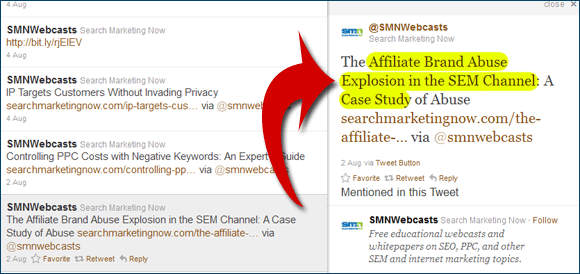Earlier this month @SMNWebcasts tweeted:

Naturally, I was among the first folks to request the whitepaper; but only now I’ve finally found time to blog about it.
The case study starts by quoting some sobering statistics from an analysis by Artinsic Interactive of “hundreds of advertisers”:
There are no hard and fast industry numbers to quantify the dollars missattributed or lost by hijacked brands, but …an average of 40% misattribution per advertiser is not unusual … and for some advertisers, it can hit 90%. Applied to projected advertiser spend on affiliate marketing, that could represent revenue misattributions of as much as $1.6 billions (40% x $4 billion) for advertisers using the channel by 2014.
While the former observation about (misattribution from 40% to 90% per advertiser) matches my own observations over the course of eight years, the latter statement may be a bit far-fetched as many of the larger affiliate programs are taking the issue extremely seriously, and monitoring such behavior.
Having said the above, I applaud Atrinsic for bringing attention to the subject of “chronic brand abuse” which happens when paid search affiliates violate merchants’ PPC bidding rules. Their case study vividly illustrates how and why trademark violators do what they do, what it means for merchants who have trademark violators aboard their affiliate programs, and what they can do to prevent this from happening. They also give some solid practical advice on protecting your brand from PPC violations. I appreciate seeing that they’ve used my blog as one of their references; but moreover I appreciate the practical angle of their white paper. Here are, for example, their “five best tips for locking down your brand”:
 Know Thyself — Or “understand what is going on with your campaigns”, equipping yourself with ways/tools to track your brand activity constantly keeping an eye on such KPIs as “CPCs, conversion, and click through rates” as well as “rank fluctuations over time, your market share deviation as compared to control group,” and also “to your hot competitors”.
Know Thyself — Or “understand what is going on with your campaigns”, equipping yourself with ways/tools to track your brand activity constantly keeping an eye on such KPIs as “CPCs, conversion, and click through rates” as well as “rank fluctuations over time, your market share deviation as compared to control group,” and also “to your hot competitors”.- Know thy Enemy…and thy Friends! — Monitor “what your competitors are doing compared to you including the top 10 biggest competitive threats, top 10 new competitors, and top 5 gainers and losers in terms of market share”; plus track also what your affiliates are doing to drive their traffic to you. I love their advice on manual approval of “everyone who comes into your program”. See, for example, this article of mine on it.
- Set the Rules and Make them Stick — Amen again! I’ve written (and spoken) time and again that you want to have precise “publisher and affiliate guidelines” and then police compliance with them.
- Integrate Search and Affiliate — I agree with the idea of integration so that date could be correctly interpreted and acted upon. I do not agree with the advice that “your affiliate program should be managed by the same division/person that manages your paid search campaigns”. It is enough for the affiliate program manager and your PPC manager to work closely together; and for the latter to have access to all relevant reports.
- Work with a Trusted Provider — This one is natural.
Overall, it’s an excellent case study — otherwise, why blog about it? — every affiliate, merchant, and affiliate program manager must review. Once again you may request it from Search Marketing Now here.
Geno, ignores one thing: Trademark Poaching on PPC has been ruled legal (to some degree) by the US Courts. YOu can’t use the name, but you can bid on the TM.
Could you please elaborate on this, Pace (preferably, including references to such cases/lawsuits)?
Network Automation v Advanced Systems. Very famous case this year where the Federal Appeals Court for Central District of California ruled that bidding on a Trademark is ok — if you aren’t using the actual name in the advertisement. Feel free to read the full ruling here: http://www.ca9.uscourts.gov/datastore/opinions/2011/03/08/10-55840.pdf
Thanks for the link, Pace.
It only proves the necessity of starting up with a solid affiliate program agreement.